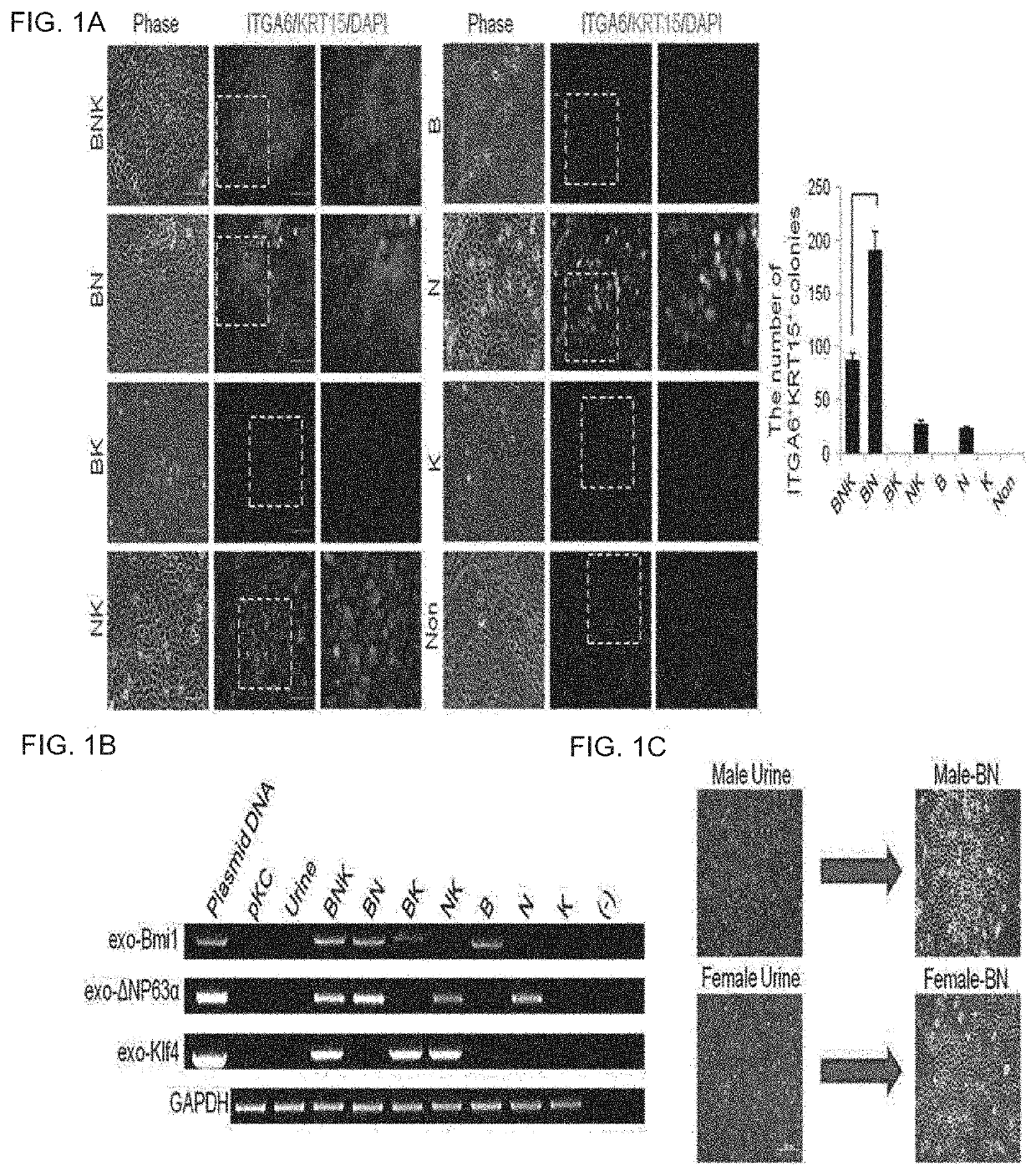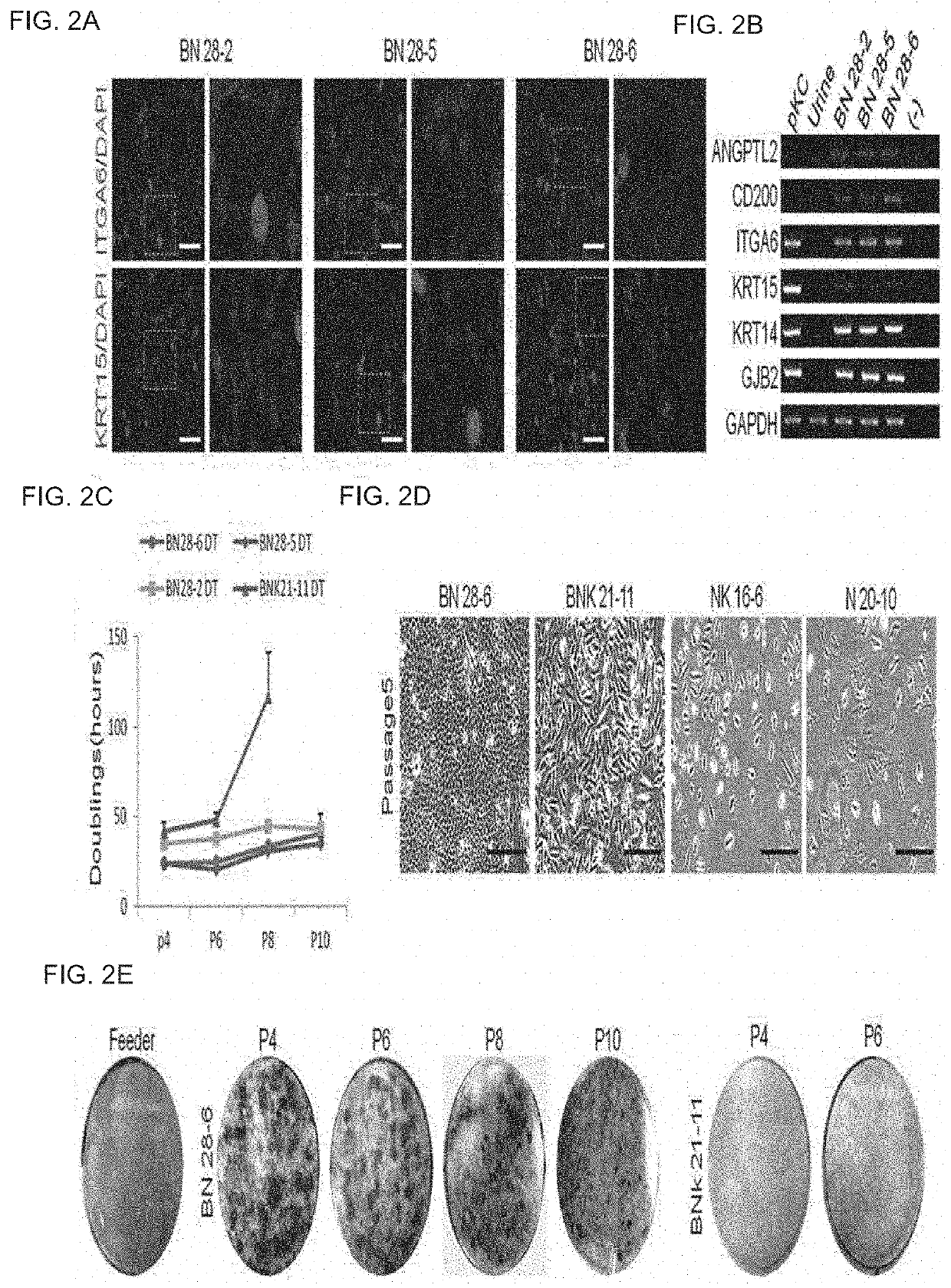Method for direct reprogramming of urine cells into keratinocyte stem cells and method for preparing composition for promoting skin regeneration using reprogrammed keratinocyte stem cells
a technology of keratinocyte stem cells and urine cells, which is applied in the direction of genital tract cells, genetically modified cells, peptide sources, etc., can solve the problems of insufficient amount of keratinocytes obtained through this procedure, and the difficulty in regenerating skin tissue arising from burns or deep wounds, so as to enhance the effect of the effect of the procedur
- Summary
- Abstract
- Description
- Claims
- Application Information
AI Technical Summary
Benefits of technology
Problems solved by technology
Method used
Image
Examples
example 1
[0077]After urine cells were centrifuged at 2,000 rpm for 10 minutes by collecting 200 ml of urine in a container, the supernatant thereof was removed. After the pellet was washed with PBS including an antibiotic and then centrifuged at 2,000 rpm for 10 minutes, the supernatant thereof was removed. The cell pellets were seeded onto a 12-well plate coated with gelatin by resuspending the cell pellets with a DMEM / F12 1: 1 medium including an antibiotic+10% FBS.
[0078]After 1 ml of the DMEM / F12 1: 1 medium including an antibiotic+10% FBS was added daily for 5 days, the medium was replaced with a medium of 5% FBS, bFGF 2.5 ng / ml, EGF 2.5 ng / ml, 44% high glucose DMEM including 0.5% L-glutamine and 0.5% penicillin-streptomycin, and a 50% renal epithelial cell growth medium (REGM). When confluence reached 95% or more, urine cells were cultured (passaging) through subculture. At Passage 3, urine cells were used to induce reprogrammed keratinocyte stem cells.
example 2
of Combination of Reprogramming Factors for Inducing of Urine-Derived Reprogrammed Keratinocyte Stem Cell Lines
[0079]In order to obtain reprogrammed keratinocyte stem cell lines, urine cells were induced into reprogrammed keratinocyte stem cells using a retroviral vector system to introduce reprogramming factors Bmi1 (B, NCBI ID:648, RefSeq: NM_005180.8), dNP63a(N, NCBI ID:8626, RefSeq: NM_001114980.1), and Klf4(K, NCBI ID: 9314, RefSeq: NM_001314052.1) into urine cells at each combination (BNK, BN, BK, NK, B, N, and K). The specific method is as follows:
[0080]In the urine cells isolated and cultured in Example 1, vectors (pMXs-Bmi1, pMXs-dNP63a, and pMXs-Klf4) constructed by inserting nucleotide sequences encoding Bmi1, dNP63a and Klf4 proteins into a pMXs vector were infected with a virus into which the reprogramming factor combination prepared using a human 293-derived retroviral packaging cell line (293GPG) was introduced, thereby introducing the reprogramming factors into urine...
example 3
ment of Urine-Derived Reprogrammed Keratinocyte Stem Cell Lines into which Bmi1 and dNP63a are Introduced
[0086]After colonies co-positive for KRT15 / ITGA6 which is a keratinocyte stem cell-specific marker were selected from colonies similar to keratinocyte stem cells among cells induced in Example 2 using a colony-picking method, reprogrammed keratinocyte stem cells BN28-2, BN28-5, and BN28-6 were established by expansion culturing the colonies in a high glucose DMEM / F12 3: 1 medium including 1% L-glutamine, 1% penicillin-streptomycin, 5 ug / ml insulin, 0.5 ug / ml hydrocortisone, 8.3 ng / ml cholera toxin, 1.37 ng / ml T3, 52.8 ug / ml ascorbic acid, 20 ng / ml EGF, and 10% FBS (FIG. 2A).
[0087]With respect to the established cell lines, the expression of the keratinocyte stem cell markers ANGPTL2, CD200, ITGA6, KRT15, KRT14, and GJB2 at the mRNA level was confirmed using primers (ANGPTL2-Forward: TACATGGCACAACGGCAAGCA (SEQ ID No. 5); ANGPTL2-Reverse: TTGGAGTGGGCACAGGCGTTAT (SEQ ID No. 6); CD20...
PUM
 Login to View More
Login to View More Abstract
Description
Claims
Application Information
 Login to View More
Login to View More - R&D
- Intellectual Property
- Life Sciences
- Materials
- Tech Scout
- Unparalleled Data Quality
- Higher Quality Content
- 60% Fewer Hallucinations
Browse by: Latest US Patents, China's latest patents, Technical Efficacy Thesaurus, Application Domain, Technology Topic, Popular Technical Reports.
© 2025 PatSnap. All rights reserved.Legal|Privacy policy|Modern Slavery Act Transparency Statement|Sitemap|About US| Contact US: help@patsnap.com



